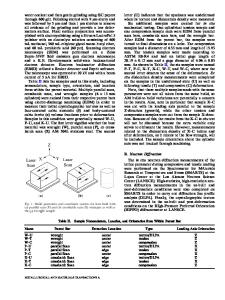Using In Situ Neutron Diffraction to Isolate Specific Features of Additively Manufactured Microstructures in 304L Stainl
- PDF / 8,083,979 Bytes
- 15 Pages / 593.972 x 792 pts Page_size
- 103 Downloads / 342 Views
ODUCTION
ADDITIVE manufacturing is a rapidly developing processing pathway that produces components by selectively melting and solidifying feedstock to build a desired geometry, rather than subtractive machining from cast or wrought material.[1–3] Similar to welding, rapid solidification and high cooling rates are experienced during additive manufacture (AM), often quoted in the range of 103 to 106 K/s,[3–5] resulting in high-energy microstructures which are distinct from those obtained from conventional
D.W. BROWN, J.S. CARPENTER, B. CLAUSEN, V. LIVESCU, R.M. MARTINEZ, B.M. MORROW, R. POKHAREL, M. STRANTZA, and S.C. VOGEL are with the Los Alamos National Laboratory, Los Alamos, NM 87545. Contact e-mail: [email protected] D.P. ADAMS is with the Sandia National Laboratories, Albuquerque, NM 87123. L. BALOGH is with the Queens University, Kingston, Ontario K7L 3N6, Canada. T.A. PALMER is with Penn State University, University Park, PA 16802. Manuscript submitted August 6, 2018. Article published online May 1, 2019 METALLURGICAL AND MATERIALS TRANSACTIONS A
casting and thermomechanical processing techniques.[4,6,7] It is not surprising then that AM materials frequently present mechanical properties such as strength, corrosion resistance, fatigue, and fracture properties that are distinct from their traditionally wrought counterparts.[8–14] Post-build heat treatments are often applied to AM materials out of necessity to develop microstructures that are well understood and can be used with confidence.[14,15] Significant research has been completed to develop heat-treatment protocols to reach desired properties without necessarily exerting informed control of the final microstructure.[16–19] Recent attempts have been made to develop a science-based understanding of the microstructure development during heat treatment,[20] specifically how the hardness of AM 304L steel varies with geometrically necessary dislocations (GNDs) controlled by post-build heat treatment. An understanding of how to manipulate the unique AM microstructural features would enable design of post-build heat treatments (or even build parameters) to achieve a desired final microstructure and, thus, final mechanical properties. In previous work on high-power laser-engineered net shaping (HP-LENS) AM steel,[21] it was demonstrated that within a single AM ‘‘flavor,’’ the high dislocation density that results from the rapid cooling and thermal VOLUME 50A, JULY 2019—3399
gradients inherent in additive manufacturing controls the enhanced strength observed in these materials relative to their wrought counterpart. However, this conclusion is clearly over simplified when applied across different additive manufacturing techniques that produce several distinct microstructural features, including grain size and morphology, phase content, and metastable chemical segregation.[6,22] In particular, it was shown that load partitioning to the small fraction of ferrite, of order 0.03, occurs differently under tension and compression. This was speculated to be due to compressive pre
Data Loading...











